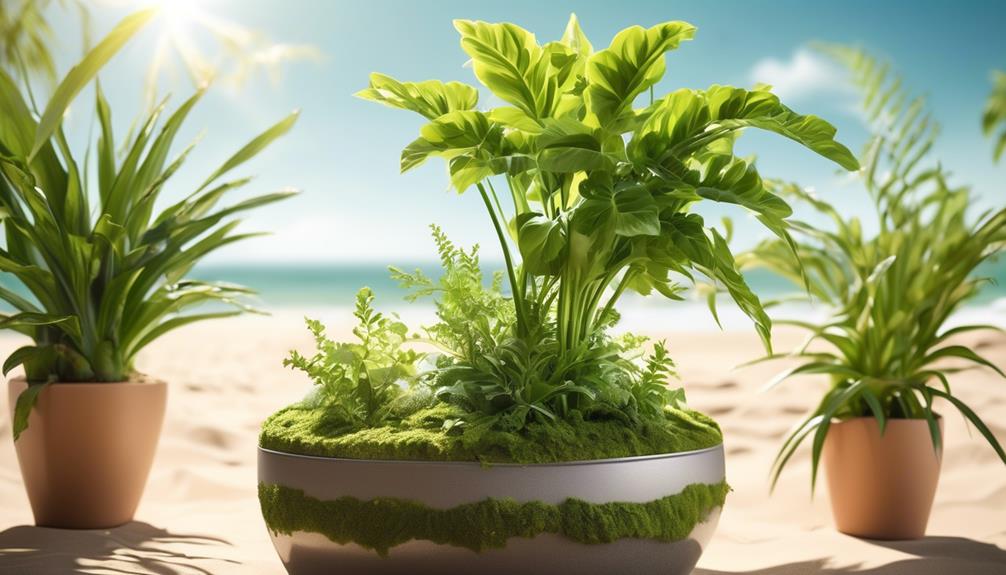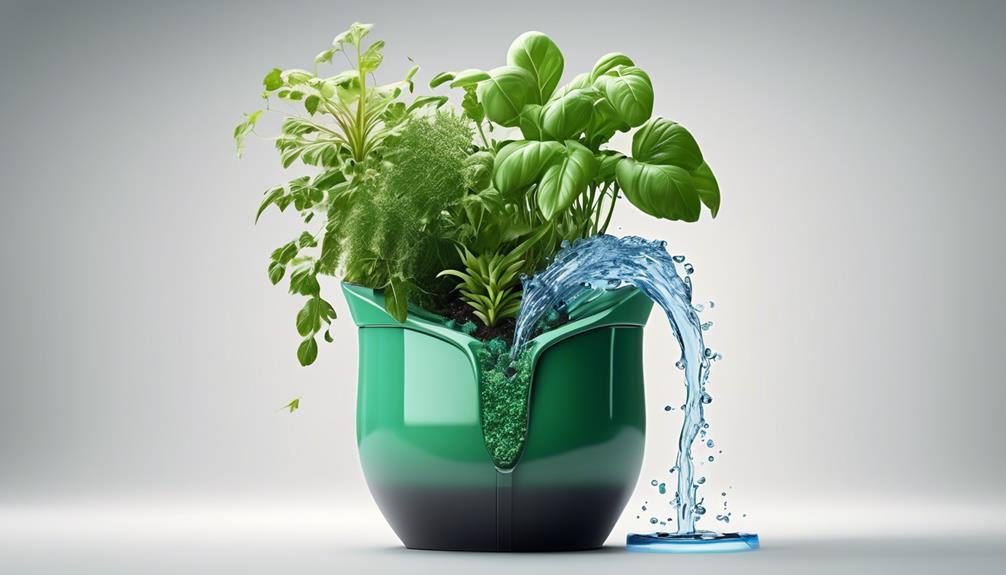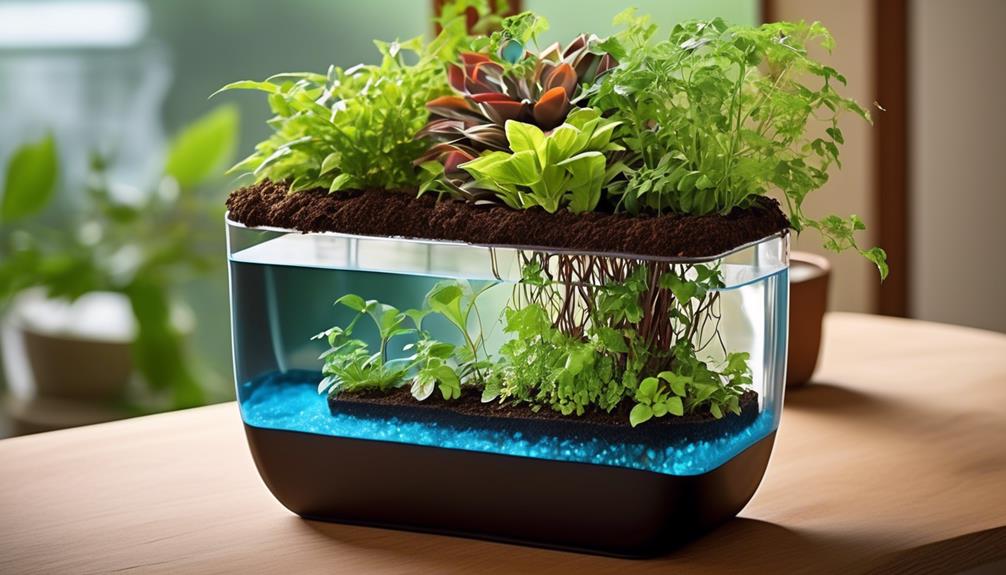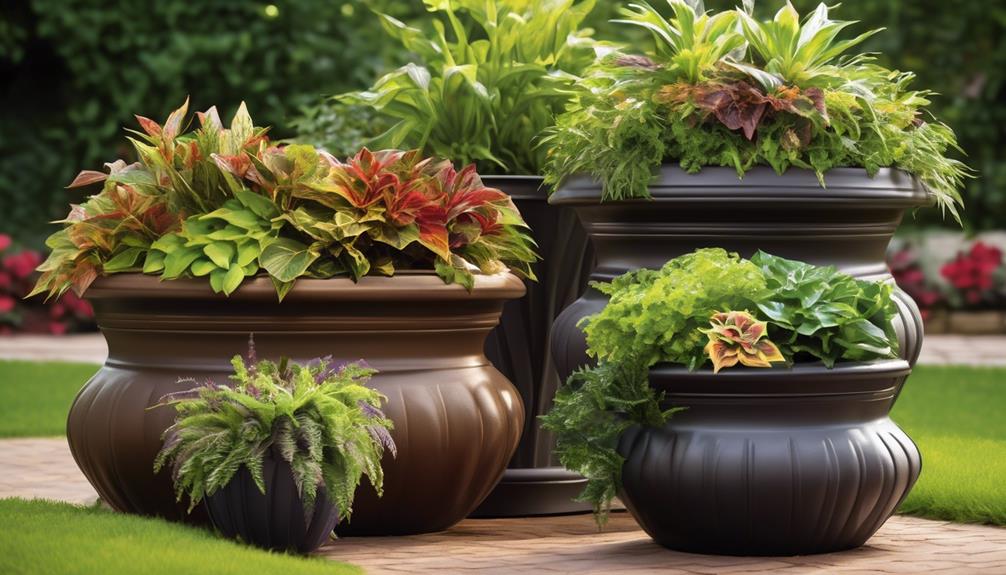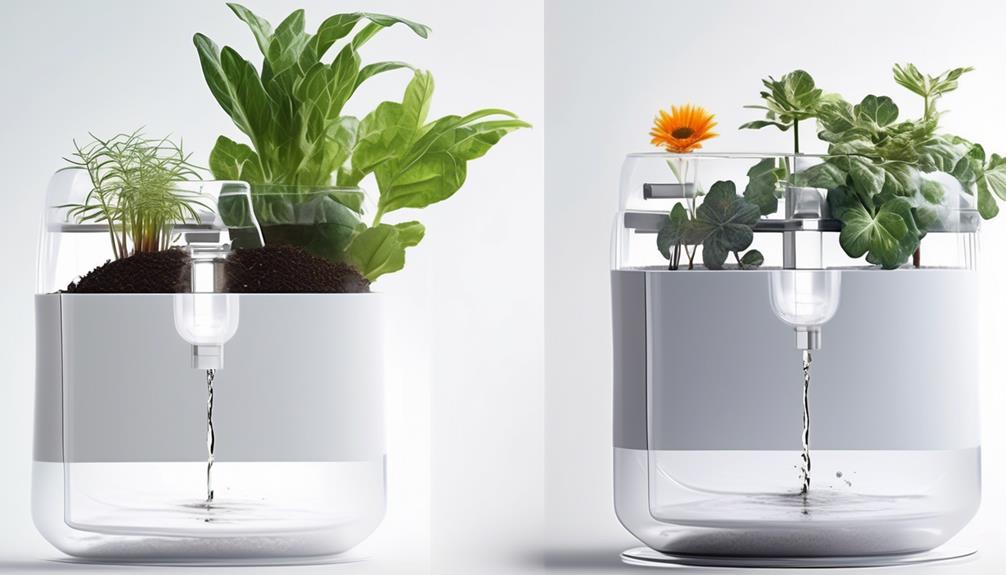We have all felt that dreadful feeling when we return from a trip and find our beloved plants looking droopy and barely surviving.
But what if there was a way to ensure our green friends stay happy and hydrated even when we're away?
Self-watering plant pots offer a solution that can alleviate the worry of plant care during our absences.
But how do they work, and are they truly reliable?
Let's explore the world of self-watering plant pots and how they can make a difference in our vacation plans.
Key Takeaways
- Self-watering plant pots provide consistently moist soil and reduce the frequency of watering required, making them ideal for maintaining plants while on vacation.
- Choosing the right self-watering pot involves considering the plant's specific needs and environmental conditions, ensuring the pot size accommodates the root system and water reservoir, and matching the reservoir capacity with the plant's water requirements.
- To set up self-watering pots for vacation, it is important to use a well-draining potting mix, perform a trial run to identify and troubleshoot any issues, and create a self-sustaining watering system.
- Maintaining self-watering pots involves monitoring the water level indicator or soil moisture regularly, using well-draining soil mix, cleaning the reservoir and potting mix to prevent algae and pests, and checking the wick or watering mechanism for blockages or damages.
Benefits of Self-Watering Plant Pots
What are the advantages of using self-watering plant pots over traditional watering methods?
Self-watering plant pots offer numerous benefits, especially for indoor gardening and plant care. These pots feature a reservoir that holds water, and through capillary action, the soil draws up the water as needed, keeping the soil consistently moist. This system provides a steady supply of water to the plant's roots, preventing under or over-watering.
One of the key advantages is the reduced frequency of watering required, making it ideal for individuals who may be away from home for extended periods, such as during vacations. This is particularly beneficial for those who are dedicated to serving others and may not have the time to tend to their plants daily.
Additionally, self-watering pots help to prevent water wastage by delivering water directly to the roots, minimizing evaporation and runoff. This efficient use of water isn't only beneficial for plant health but also contributes to environmental sustainability.
Choosing the Right Self-Watering Pot

When selecting a self-watering pot, it's important to consider the specific needs of the plant and the environmental conditions in which it will be placed. One crucial factor to consider is the pot size. The pot should be appropriately sized to accommodate the plant's root system and provide ample space for the water reservoir. A pot that's too small may not hold enough water to sustain the plant, while a pot that's too large could lead to overwatering, posing a risk to the plant's health.
Understanding water reservoirs is equally important. Different self-watering pots have varying reservoir capacities, and this should align with the plant's water requirements. For instance, plants in hot and dry environments will require larger reservoirs compared to those in cooler, more humid conditions. It's essential to match the pot's water capacity with the plant's specific needs to ensure optimal growth and health.
Setting Up Self-Watering Pots for Vacation
To ensure proper hydration for your plants while you're away, it's essential to set up self-watering pots in a way that meets their specific watering needs. Here's how to set up self-watering pots for vacation:
- Choose the Right Self-Watering System: Select a self-watering system that suits the needs of your plants. Options include wicks, reservoirs, and capillary mats. Each system works differently, so it's important to match the system to the plant's water requirements.
- Prepare the Potting Mix: Use a well-draining potting mix to prevent waterlogging, which can lead to root rot in self-watering pots. A mix with a combination of peat, perlite, and vermiculite works well. Ensure the potting mix is thoroughly moistened before setting up the self-watering system.
- Troubleshoot Potential Issues: Before leaving for vacation, perform a trial run with the self-watering system to identify and troubleshoot any potential issues. Check for proper water flow, adjust the watering rate as needed, and ensure that the system is functioning effectively.
Setting up self-watering pots for vacation using DIY self-watering systems requires careful consideration of the plant's needs and potential issues that may arise. By following these steps, you can create a self-sustaining watering system that will keep your plants healthy while you're away.
Maintenance Tips for Self-Watering Pots
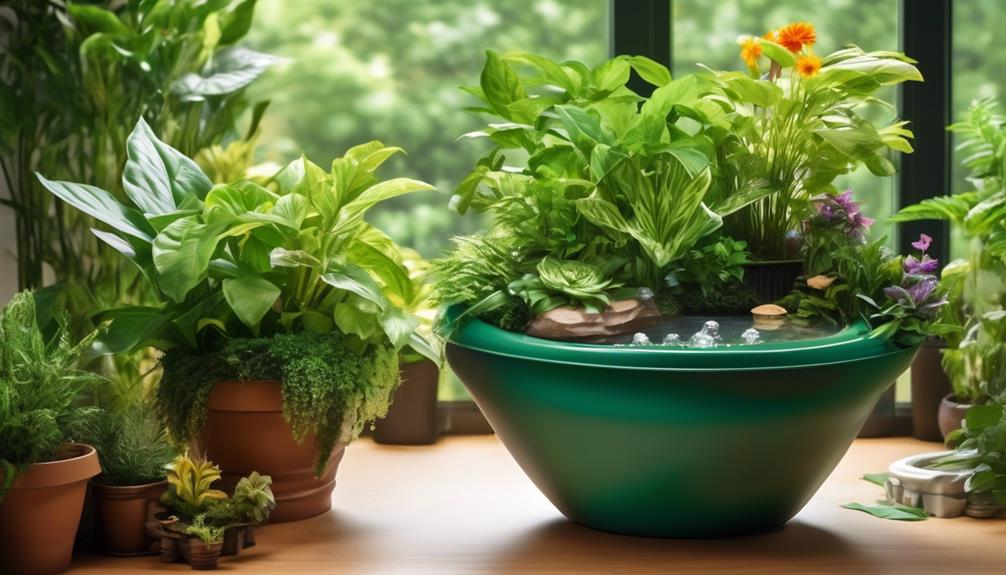
Regular maintenance is essential for ensuring the optimal functioning of self-watering pots and the health of the plants they support. To avoid overwatering, it's crucial to monitor the water level indicator or observe the soil moisture regularly. This helps in adjusting the watering frequency according to the plant's needs.
Additionally, choosing the right soil mix is vital for the overall health of the plants. A well-draining soil mix that retains moisture without becoming waterlogged is ideal. Regularly inspect the soil mix to ensure it's providing adequate aeration and moisture retention.
Furthermore, cleaning the reservoir and potting mix from time to time helps in preventing the growth of algae, mold, and pests. It's also important to check the wick or watering mechanism for any blockages or damages, as these can affect the water distribution to the plant. Trimming any roots that may be blocking the wick system is also essential for maintaining proper functioning.
Maximizing Plant Health With Self-Watering Pots
Maximizing plant health with self-watering pots involves carefully monitoring the soil moisture and adjusting the watering frequency to meet the specific needs of the plants. By implementing the following strategies, we can improve growth and reduce maintenance:
- Soil Moisture Monitoring: Regularly check the soil moisture using a moisture meter or by simply inserting a finger into the soil. This helps in understanding the water requirements of the plants and prevents over or under-watering.
- Adjusting Watering Frequency: Based on the moisture levels, adjust the watering frequency. During warmer months or when the plants are actively growing, they may require more frequent watering, whereas during colder months or dormant phases, the watering frequency can be reduced.
- Nutrient Management: Self-watering pots can lead to leaching of nutrients due to continuous watering. Incorporating slow-release fertilizers or organic compost can ensure that the plants receive essential nutrients, thereby promoting healthy growth.
Frequently Asked Questions
Can Self-Watering Plant Pots Be Used for All Types of Plants, Including Succulents and Cacti?
Yes, self-watering plant pots can be used for all types of plants, including succulents and cacti.
Succulents require less frequent watering, and self-watering pots are ideal for maintaining their moisture levels.
Cacti also benefit from the controlled watering system of self-watering pots.
They can be used for outdoor plants, providing a convenient solution for maintaining proper moisture levels, especially during hot and dry weather conditions.
Are There Any Specific Safety Concerns or Risks Associated With Using Self-Watering Plant Pots While on Vacation?
When considering watering frequency, it's crucial to prioritize plant health. We aim to ensure that the plants receive adequate water without the risk of overwatering, which can lead to root rot and other issues.
It's important to monitor the soil moisture levels and adjust the watering schedule accordingly. Our focus is on maintaining optimal conditions for plant growth and vitality, which requires a balanced approach to watering.
How Often Should the Water Reservoir in a Self-Watering Pot Be Refilled, Especially for Larger Plants?
When considering the watering frequency for larger plants in self-watering pots, it's crucial to factor in the plant size, watering efficiency, and whether the pot is being used indoors or outdoors.
The refilling frequency will vary based on these factors, with larger plants generally requiring more frequent refills.
It's important to monitor the water reservoir regularly to ensure the plant receives the appropriate hydration.
Can Self-Watering Plant Pots Be Used Outdoors, and if So, What Special Considerations Should Be Taken Into Account?
Yes, self-watering plant pots can be used outdoors.
When considering outdoor use, it's important to factor in sunlight exposure, temperature fluctuations, and potential evaporation.
To optimize performance, ensure the pots have adequate drainage, use a suitable growing medium, and monitor water levels regularly.
Additionally, consider the impact of weather conditions on the reservoir and plant growth.
Following these maintenance tips can help ensure successful outdoor use of self-watering plant pots.
Are There Any Potential Drawbacks or Limitations to Using Self-Watering Plant Pots, Such as Specific Plant Requirements or Environmental Factors?
Are there potential drawbacks or limitations to using self-watering plant pots?
When considering plant requirements and environmental factors, specific safety concerns should be addressed. It's crucial to understand the limitations of these pots, especially in relation to the type of plant being grown and the environmental conditions.
We must also consider the potential risks when using these pots, particularly during vacations.
It's essential to analyze these factors to ensure successful plant care.
Are Self Watering Plant Pots Suitable for Outdoor Use, Especially for Vacations?
Yes, self watering plant pots outdoor are ideal for outdoor use, especially during vacations. These pots can keep plants hydrated for longer periods, reducing the need for frequent watering. This makes them perfect for outdoor settings, where access to water may be limited while you’re away.
Conclusion
In conclusion, self-watering plant pots offer a convenient and efficient way to keep your plants hydrated, especially during vacation. By choosing the right pots, setting them up properly, and following maintenance tips, you can ensure your plants stay healthy and thriving even in your absence.
Remember, 'a watched pot never boils,' so trust in the self-watering system to do its job and enjoy peace of mind while you're away.

